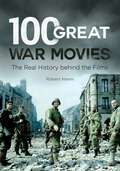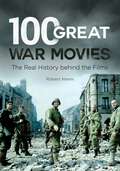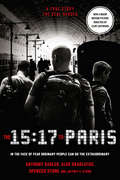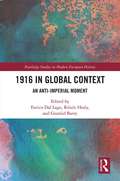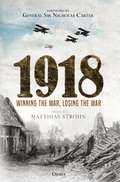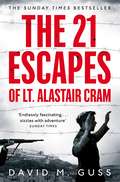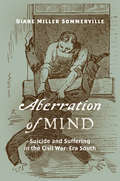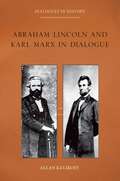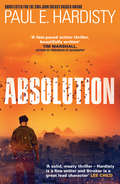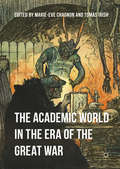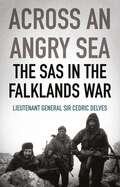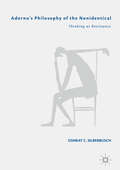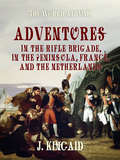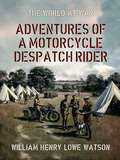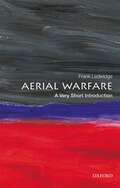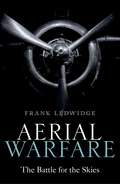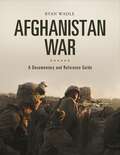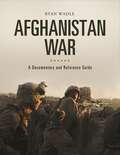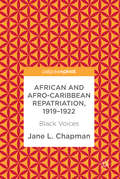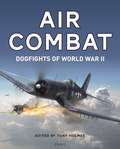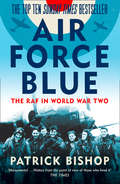- Table View
- List View
100 Great War Movies: The Real History behind the Films
by Robert J. NiemiThis book serves as a fascinating guide to 100 war films from 1930 to the present. Readers interested in war movies will learn surprising anecdotes about these films and will have all their questions about the films' historical accuracy answered.This cinematic guide to war movies spans 800 years in its analysis of films from those set in the 13th century Scottish Wars of Independence (Braveheart) to those taking place during the 21st-century war in Afghanistan (Lone Survivor). World War II has produced the largest number of war movies and continues to spawn recently released films such as Dunkirk. This book explores those, but also examines films set during such conflicts as the Napoleonic Wars, the American Civil War, World War I, the Vietnam War, and the wars in Afghanistan and Iraq.The book is organized alphabetically by film title, making it easy to navigate. Each entry is divided into five sections: Background (a brief discussion of the film's genesis and financing); Production (information about how, where, and when the film was shot); Synopsis (a detailed plot summary); Reception (how the film did in terms of box office, awards, and reviews) and "Reel History vs. Real History" (a brief analysis of the film's historical accuracy). This book is ideal for readers looking to get a vivid behind-the-scenes look at the greatest war movies ever made.
100 Great War Movies: The Real History behind the Films
by Robert J. NiemiThis book serves as a fascinating guide to 100 war films from 1930 to the present. Readers interested in war movies will learn surprising anecdotes about these films and will have all their questions about the films' historical accuracy answered.This cinematic guide to war movies spans 800 years in its analysis of films from those set in the 13th century Scottish Wars of Independence (Braveheart) to those taking place during the 21st-century war in Afghanistan (Lone Survivor). World War II has produced the largest number of war movies and continues to spawn recently released films such as Dunkirk. This book explores those, but also examines films set during such conflicts as the Napoleonic Wars, the American Civil War, World War I, the Vietnam War, and the wars in Afghanistan and Iraq.The book is organized alphabetically by film title, making it easy to navigate. Each entry is divided into five sections: Background (a brief discussion of the film's genesis and financing); Production (information about how, where, and when the film was shot); Synopsis (a detailed plot summary); Reception (how the film did in terms of box office, awards, and reviews) and "Reel History vs. Real History" (a brief analysis of the film's historical accuracy). This book is ideal for readers looking to get a vivid behind-the-scenes look at the greatest war movies ever made.
The 15: The True Story Of A Terrorist, A Train And Three American Heroes
by Anthony Sadler Alek Skarlatos Spencer StoneThe 15:17 to Paris is the amazing true story of friendship and bravery, and of near tragedy averted by three heroic young men who found the unity and strength inside themselves when they – and 500 other innocent travellers – needed it most.
1916 in Global Context: An anti-Imperial moment (Routledge Studies in Modern European History)
by Enrico Dal Lago Róisín Healy Gearóid BarryThe year 1916 has recently been identified as "a tipping point for the intensification of protests, riots, uprisings and even revolutions." Many of these constituted a challenge to the international pre-war order of empires, and thus collectively represent a global anti-imperial moment, which was the revolutionary counterpart to the later diplomatic attempt to construct a new world order in the so-called Wilsonian moment. Chief among such events was the Easter Rising in Ireland, an occurrence that took on worldwide significance as a challenge to the established order. This is the first collection of specialist studies that aims at interpreting the global significance of the year 1916 in the decline of empires.
1916 in Global Context: An anti-Imperial moment (Routledge Studies in Modern European History)
by Enrico Dal Lago Róisín Healy Gearóid BarryThe year 1916 has recently been identified as "a tipping point for the intensification of protests, riots, uprisings and even revolutions." Many of these constituted a challenge to the international pre-war order of empires, and thus collectively represent a global anti-imperial moment, which was the revolutionary counterpart to the later diplomatic attempt to construct a new world order in the so-called Wilsonian moment. Chief among such events was the Easter Rising in Ireland, an occurrence that took on worldwide significance as a challenge to the established order. This is the first collection of specialist studies that aims at interpreting the global significance of the year 1916 in the decline of empires.
1918: Winning the War, Losing the War (Cambridge Military Histories Ser.)
by Nicholas Carter Matthias Strohn James S. Corum Maj Gen Mungo Melvin CB OBE David T. Zabecki David Murphy Jonathan Boff Mitch Yockelson Lothar Höbelt Dr Robert Johnson Michael EpkenhansIn 2018, the world will be commemorating the centenary of the end of the First World War. In many ways, 1918 was the most dramatic year of the conflict. After the defeat of Russia in 1917, the Germans were able to concentrate their forces on the Western Front for the first time in the war, and the German offensives launched from March 1918 onward brought the Western Allies close to defeat. Having stopped the German offensives, the Entente started its counter-attacks on all fronts with the assistance of fresh US troops, driving the Germans back and, by November 1918, the Central Powers had been defeated. This new study is a multi-author work containing ten chapters by some of the best historians of the First World War from around the world writing today. It provides an overview and analysis of the different levels of war for each of the main armies involved within the changing context of the reality of warfare in 1918. It also looks in detail at the war at sea and in the air, and considers the aftermath and legacy of the First World War.
The 21 Escapes of Lt Alastair Cram: A compelling story of courage and endurance in the Second World War
by David M. Guss'Endlessly fascinating. Cram's story sizzles with adventure.' Giles Milton, Sunday TimesA genuinely new Second World War story, The 21 Escapes of Lt Alastair Cram is a riveting account of the wartime exploits of Alastair Cram, brilliantly told by the American author, David Guss. Cram was taken prisoner in North Africa in November 1941, which began a long odyssey through twelve different POW camps, three Gestapo prisons and one asylum. He became a serial escapee – fleeing his captors no fewer than twenty-one times, including his final, and finally successful, escape from a POW column in April 1945. Perhaps the most dramatic of his attempts was from Gavi, the ‘Italian Colditz’. Gavi was a maximum-security prison near Genoa for the pericolosi, the ‘most dangerous’ inmates because of their perpetual hunger to escape. It was here that Alastair met David Stirling, the legendary founder of the SAS, and cooked up the plan for what would become the ‘Cistern Tunnel’ escape, one of the most audacious but hitherto little-known mass escape attempts of the entire war. A story of courage in the face of extraordinary odds, it is a testament to one man's dogged determination never to give up.
Aberration of Mind: Suicide and Suffering in the Civil War–Era South
by Diane Miller SommervilleMore than 150 years after its end, we still struggle to understand the full extent of the human toll of the Civil War and the psychological crisis it created. In Aberration of Mind, Diane Miller Sommerville offers the first book-length treatment of suicide in the South during the Civil War era, giving us insight into both white and black communities, Confederate soldiers and their families, as well as the enslaved and newly freed. With a thorough examination of the dynamics of both racial and gendered dimensions of psychological distress, Sommerville reveals how the suffering experienced by Southerners living in a war zone generated trauma that, in extreme cases, led some Southerners to contemplate or act on suicidal thoughts.Sommerville recovers previously hidden stories of individuals exhibiting suicidal activity or aberrant psychological behavior she links to the war and its aftermath. This work adds crucial nuance to our understanding of how personal suffering shaped the way southerners viewed themselves in the Civil War era and underscores the full human costs of war.
Aberration of Mind: Suicide and Suffering in the Civil War–Era South
by Diane Miller SommervilleMore than 150 years after its end, we still struggle to understand the full extent of the human toll of the Civil War and the psychological crisis it created. In Aberration of Mind, Diane Miller Sommerville offers the first book-length treatment of suicide in the South during the Civil War era, giving us insight into both white and black communities, Confederate soldiers and their families, as well as the enslaved and newly freed. With a thorough examination of the dynamics of both racial and gendered dimensions of psychological distress, Sommerville reveals how the suffering experienced by Southerners living in a war zone generated trauma that, in extreme cases, led some Southerners to contemplate or act on suicidal thoughts. Sommerville recovers previously hidden stories of individuals exhibiting suicidal activity or aberrant psychological behavior she links to the war and its aftermath. This work adds crucial nuance to our understanding of how personal suffering shaped the way southerners viewed themselves in the Civil War era and underscores the full human costs of war.
Aberration of Mind: Suicide and Suffering in the Civil War–Era South
by Diane Miller SommervilleMore than 150 years after its end, we still struggle to understand the full extent of the human toll of the Civil War and the psychological crisis it created. In Aberration of Mind, Diane Miller Sommerville offers the first book-length treatment of suicide in the South during the Civil War era, giving us insight into both white and black communities, Confederate soldiers and their families, as well as the enslaved and newly freed. With a thorough examination of the dynamics of both racial and gendered dimensions of psychological distress, Sommerville reveals how the suffering experienced by Southerners living in a war zone generated trauma that, in extreme cases, led some Southerners to contemplate or act on suicidal thoughts. Sommerville recovers previously hidden stories of individuals exhibiting suicidal activity or aberrant psychological behavior she links to the war and its aftermath. This work adds crucial nuance to our understanding of how personal suffering shaped the way southerners viewed themselves in the Civil War era and underscores the full human costs of war.
ABRAH LINCOLN & KARL MARX IN DIALOGUE C (Dialogues in History)
by Allan KulikoffWhy put Abraham Lincoln, the sometime corporate lawyer and American President, in dialogue with Karl Marx, the intellectual revolutionary? On the surface, they would appear to share few interests. Yet, though Lincoln and Marx never met one another, both had an abiding interest in the most important issue of the nineteenth-century Atlantic world-the condition of labor in a capitalist world, one that linked slave labor in the American south to England's (and continental Europe's) dark satanic mills. Each sought solutions--Lincoln through a polity that supported free men, free soil, and free labor; Marx by organizing the working class to resist capitalist exploitation. While both men espoused emancipation for American slaves, here their agreements ended. Lincoln thought that the free labor society of the American North provided great opportunities for free men missing from the American South, a kind of "farm ladder" that gave every man the ability to become a landowner. Marx thought such "free land" a chimera and (with information from German-American correspondents), was certain that the American future lay in the proletarianized cities. Abraham Lincoln and Karl Marx in Dialogue intersperses short selections from the two writers from their voluminous works, opening with an introduction that puts the ideas of the two men in the broad context of nineteenth-century thought and politics. The volume excerpts Lincoln's and Marx's views on slavery (they both opposed it for different reasons), the Civil War (Marx claimed the war concerned slavery and should have as its goal abolition; Lincoln insisted that his goal was just the defeat of the Confederacy), and the opportunities American free men had to gain land and economic independence. Through this volume, readers will gain a firmer understanding of nineteenth-century labor relations throughout the Atlantic world: slavery and free labor; the interconnections between slave-made cotton and the exploitation of English proletarians; and the global impact of the American Civil War.
Absolution (Claymore Straker #4)
by Paul E. HardistyIt’s 1997, and eight months since vigilante justice-seeker Claymore Straker fled South Africa after his explosive testimony to Desmond Tutu’s Truth and Reconciliation Commission.In Paris, Rania LaTour, Claymore’s former lover, comes home to find that her son and her husband, a celebrated human rights lawyer, have disappeared.On an isolated island off the coast of East Africa, the family that Clay has befriended is murdered as he watches.So begins the fourth instalment in the Claymore Straker series, a breakneck journey through the darkest reaches of the human soul, as Clay and Rain fight to uncover the mystery behind the disappearances and murders, and find those responsible.Relentlessly pursued by those who want them dead, they must work together to uncover the truth, and to find a way to survive in a world gone mad.At times brutal, often lyrical, but always gripping, Absolution is a thriller that will leave you breathless and questioning the very basis of how we live and why we love.‘A trenchant and engaging thriller that unravels this mysterious land in cool, precise sentences’ Stav Sherez, Catholic Herald‘This is a remarkably well-written, sophisticated novel in which the people and places, as well as frequent scenes of violent action, all come alive on the page...’ Literary Review‘Gripping and exciting … the quality of Hardisty’s writing and the underlying truth of his plots sets this above many other thrillers’ West Australian‘Searing … at times achieves the level of genuine poetry’ Publishers Weekly‘A stormer of a thriller - vividly written, utterly tropical, totally gripping’ Peter James‘Beautifully written, blisteringly authentic, heart-stoppingly tense and unusually moving’ Paul Johnston‘The plot burns through petrol, with multiple twists and turns’ Vicky Newham‘A solid, meaty thriller – Hardisty is a fine writer and Straker is a great lead character’ Lee Child‘A fast-paced action thriller, beautifully written’ Tim Marshall, author of Prisoners of Geography
The Academic World in the Era of the Great War
by Tomás Irish Marie-Eve ChagnonThis book examines the ways in which scholarly expertise was mobilized during the First World War, and the consequences of this for the inter-connected academic world that had developed in the late nineteenth century. Adopting a strong international approach, the contributors to this volume examine the impact of the War on individuals, institutions, and disciplines, cumulatively demonstrating the strong afterlife of conflict for scholarly practices and academic communities across Europe and North America, in the decades following the cessation of the Great War.
Across an Angry Sea: The SAS in the Falklands War
by Cedric DelvesIn early summer 1982--winter in the South Atlantic--Argentina's military junta invades the Falklands. Within days, a British Royal Navy Task Force is assembled and dispatched. This is the story of D Squadron, 22 SAS, commanded by Cedric Delves. The relentless tempo of events defies belief. Raging seas, inhospitable glaciers, hurricane-force winds, helicopter crashes, raids behind enemy lines--the Squadron prevailed against them all, but the cost was high. Eight died and more were wounded or captured. Holding fast to their humanity, D Squadron's fighters were there at the start and end of the Falklands War, the first to raise a Union Jack over Government House in Stanley. Across an Angry Sea is a chronicle of daring, skill and steadfastness among a tight-knit band of brothers; of going awry, learning fast, fighting hard, and winning through.
Adorno’s Philosophy of the Nonidentical: Thinking as Resistance
by Oshrat C. SilberbuschThis book focuses on a central notion in Theodor. W. Adorno’s philosophy: the nonidentical. The nonidentical is what our conceptual framework cannot grasp and must therefore silence, the unexpressed other of our rational engagement with the world. This study presents the nonidentical as the multidimensional centerpiece of Adorno’s reflections on subjectivity, truth, suffering, history, art, morality and politics, revealing the intimate relationship between how and what we think. Adorno’s work, written in the shadow of Auschwitz, is a quest for a different way of thinking, one that would give the nonidentical a voice – as the somatic in reasoning, the ephemeral in truth, the aesthetic in cognition, the other in society. Adorno’s philosophy of the nonidentical reveals itself not only as a powerful hermeneutics of the past, but also as an important tool for the understanding of modern phenomena such as xenophobia, populism, political polarization, identity politics, and systemic racism.
Adventures in the Rifle Brigade, in the Peninsula, France, and the Netherlands (The World At War)
by John KincaidThe memoirs of Capt. J. Kincaid covering his experiences in the famous Rifle Brigade. The Rifle Brigade (Prince Consort's Own) was an infantry rifle regiment of the British Army, formed in 1800 to provide sharpshooters, scouts and skirmishers. They later became part of the Royal Green Jackets. The brigade was distinguished by its use of green uniforms as standard in place of the traditional red, the first regular infantry corps in the British Army to do so.
Adventures of a Motorcycle Despatch Rider (The World At War)
by William Henry Lowe WatsonCaptain William Henry Lowe Watson (1891-1932) was the British author of Adventures of a Despatch Rider (1915). (Excerpt) "This book is not a history, a military treatise, an essay, or a scrap of autobiography. It has no more accuracy or literary merit than letters usually possess. So I hope you will not judge it too harshly. My only object is to try and show as truthfully as I can the part played in this monstrous war by a despatch rider during the months from August 1914 to February 1915. If that object is gained I am content."
Aerial Warfare: The Battle For The Skies (Very Short Introductions)
by Frank LedwidgeAerial warfare has dominated war-making for over 100 years, and despite regular announcements of its demise, it shows no sign of becoming obsolete. In this Very Short Introduction Frank Ledwidge offers a sweeping look at the history of aerial warfare, introducing the major battles, crises, and controversies where air power has taken centre stage, and the changes in technology and air power capabilities over time. Highlighting the role played by air power in the First and Second World Wars, he also sheds light on the lesser-known theatres where the roles of air forces have been clearly decisive in conflicts, in Africa, South America, and Asia. Along the way, Ledwidge asks key questions about the roles air power can deliver, and whether it is conceptually different from other forms of combat. Considering whether bombing has ever been truly effective, he discusses whether wars can be won from the air, and concludes by analysing whether there is a future for manned air power, or if it is inevitable that drones will dominate 21st century war in the air. ABOUT THE SERIES: The Very Short Introductions series from Oxford University Press contains hundreds of titles in almost every subject area. These pocket-sized books are the perfect way to get ahead in a new subject quickly. Our expert authors combine facts, analysis, perspective, new ideas, and enthusiasm to make interesting and challenging topics highly readable. Previously published in hardback as Aerial Warfare: The Battle for the Skies.
Aerial Warfare: The Battle for the Skies (Very Short Introductions Ser.)
by Frank LedwidgeAerial warfare which has dominated western war-making for over 100 years, and despite regular announcements of its demise, it shows no sign of becoming obsolete. Frank Ledwidge offers a sweeping look at the history of air warfare, introducing the major battles, crises, and controversies where air power has taken centre stage, and the changes in technology and air power capabilities over time. Highlighting the role played by air power in the First and Second World Wars, he also sheds light on the lesser-known theatres where the roles of air forces have been clearly decisive in conflicts, in Africa, South America, and Asia. Along the way, Ledwidge asks key questions about the roles air power can deliver, and whether it is conceptually different from other forms of combat. Considering whether bombing has ever been truly effective, he discusses whether wars can be won from the air, and concludes by analysing whether there is a future for manned air power, or if it is inevitable that drones will dominate 21st century war in the air.
Afghanistan War: A Documentary and Reference Guide (Documentary and Reference Guides)
by Ryan WadleProviding an invaluable introductory resource for students investigating the war in Afghanistan, this book highlights the evolution of the conflict through the documents that helped to shape it.This carefully curated primary source collection includes more than 80 documents from the national and international participants in nearly four decades of conflict that led to the Afghanistan War. Readers will gain an understanding of the macro and micro costs of the war on the participants and the political, social, economic, and military factors that have allowed the fighting to persist. Authored by a former member of the Afghanistan Study Team at the U.S. Army's Combat Studies Institute, readers will gain special insight into the military dynamics of the war in Afghanistan and how the war has changed those who have fought in it.The book is divided into four chapters that cover the primary phases of the war in Afghanistan: The Soviet Invasion and Civil War, 1979–2001; Operation ENDURING FREEDOM and Reconstruction Begins, 2001–2003; The Taliban Return, 2003–2009; and The Surge, Drawdown, and an Uncertain Future, 2009–2017. This structure enables readers to clearly understand how the war evolved and the most significant developments that shaped each period.
Afghanistan War: A Documentary and Reference Guide (Documentary and Reference Guides)
by Ryan WadleProviding an invaluable introductory resource for students investigating the war in Afghanistan, this book highlights the evolution of the conflict through the documents that helped to shape it.This carefully curated primary source collection includes more than 80 documents from the national and international participants in nearly four decades of conflict that led to the Afghanistan War. Readers will gain an understanding of the macro and micro costs of the war on the participants and the political, social, economic, and military factors that have allowed the fighting to persist. Authored by a former member of the Afghanistan Study Team at the U.S. Army's Combat Studies Institute, readers will gain special insight into the military dynamics of the war in Afghanistan and how the war has changed those who have fought in it.The book is divided into four chapters that cover the primary phases of the war in Afghanistan: The Soviet Invasion and Civil War, 1979–2001; Operation ENDURING FREEDOM and Reconstruction Begins, 2001–2003; The Taliban Return, 2003–2009; and The Surge, Drawdown, and an Uncertain Future, 2009–2017. This structure enables readers to clearly understand how the war evolved and the most significant developments that shaped each period.
African and Afro-Caribbean Repatriation, 1919–1922: Black Voices
by Jane L. ChapmanThis book is the first attempt to analyse records of people of Afro-Caribbean origin who appealed against repatriation during the painful period after Britain’s 1919 race riots. Revealing personal letters and petitions from the West Indies, West Africa, and the UK, Jane Chapman demonstrates that conflict adjustment involving individual voices needs to be highlighted. She asks, what was the human environment, the dilemmas and the racist compulsions making transnational experiences in the British Empire so poignant? Analysing both the opinions of civil servants on appellants’ statements of hardship and requests for financial help, and the voices of the appellants themselves, this book aims to rediscover black people’s hidden heritage.
African and Afro-Caribbean Repatriation, 1919–1922: Black Voices
by Jane L. ChapmanThis book is the first attempt to analyse records of people of Afro-Caribbean origin who appealed against repatriation during the painful period after Britain’s 1919 race riots. Revealing personal letters and petitions from the West Indies, West Africa, and the UK, Jane Chapman demonstrates that conflict adjustment involving individual voices needs to be highlighted. She asks, what was the human environment, the dilemmas and the racist compulsions making transnational experiences in the British Empire so poignant? Analysing both the opinions of civil servants on appellants’ statements of hardship and requests for financial help, and the voices of the appellants themselves, this book aims to rediscover black people’s hidden heritage.
Air Combat: Dogfights of World War II
by Tony Holmes Edward M. Young Aleksander Medved Dmitriy KhazanovThe battle for the skies in World War II fuelled a race between rival air forces to develop ever faster and more capable fighter aircraft – and the struggle for air superiority was never over until the war itself ended. This volume explores four clashes of some of the finest planes and pilots, in key theatres of the war: Spitfires duelling the formidable Bf 109 over the Channel, the Fw 190 battling the Soviet La 5 and 7 on the Eastern Front, the F4F Wildcat in a desperate clash with the legendary A6M Zero-sen, and the F4U Corsair in combat with the second-generation Japanese Ki-84 in the closing days of the war.Fully illustrated with contemporary photographs, maps and colour artwork, Air Combat conveys the full story behind these dramatic aviation duels.
Air Force Blue: The Raf In World War Two - Spearhead Of Victory
by Patrick BishopIn 2018 the RAF is one hundred years old. In his new book, destined to be a classic, Patrick Bishop examines the high point of its existence – the Second World War, when the Air Force saved the nation from defeat then led the advance to victory. A SUNDAY TIMES BESTSELLER
